Services on Demand
Journal
Article
Indicators
-
 Cited by SciELO
Cited by SciELO -
 Access statistics
Access statistics
Related links
-
 Cited by Google
Cited by Google -
 Similars in
SciELO
Similars in
SciELO -
 Similars in Google
Similars in Google
Share
DYNA
Print version ISSN 0012-7353On-line version ISSN 2346-2183
Dyna rev.fac.nac.minas vol.78 no.170 Medellín Dec. 2011
NATURAL RESOURCES SUSTAINABILITY: IRON ORE MINING
LA SOSTENIBILIDAD EN LOS RECURSOS NATURALES: LA EXPLOTACIÓN DEL HIERRO
LUIS DE LA TORRE DE PALACIOS
Dr (c), Ing. de Minas, Universidad Politécnica de Madrid, ETSI Minas, ltp@coimce.com
Received for review: March 17th, 2011; accepted: April 23rd, 2011; final version: May 2nd, 2011
ABSTRACT: In the present article, a new tool to determine environmental sustainability, the energy impact index (EII) was developed to classify different iron mine projects according to two main parameters including energy consumption and CO2 emissions. The EII considers the characteristics of the mineral (such as the quality, size, hardness, iron ore grade, reducibility, mineral/waste rate, and type of deposit), mining processes (type of exploitation, ore processing, available technology), and transportation (distance to cover).
KEYWORDS: Sustainability, iron, energy, CO2 emissions
RESUMEN: A través de este trabajo se desarrolla una nueva herramienta de sostenibilidad ambiental (Índice de Impacto Energético, IIE) para la clasificación de los diversos proyectos en minas de hierro, analizando dos parámetros principales: el consumo de energía y las consecuentes emisiones de CO2. El IIE tiene en cuenta diferentes propiedades del mineral (calidad, tamaño, dureza, ley, reducibilidad, ratio mineral/estéril y tipo de yacimiento), el proceso minero (método de explotación, mineralurgia o tecnología aplicada) y el transporte (considerando distancias recorridas).
PALABRAS CLAVE: Sostenibilidad, hierro, energía, emisiones CO2
1. INTRODUCTION
Mining sustainability has been of significant interest to the mining industry since the mid-1990s [1]. Currently, mining companies have different tools to show their commitment to the values of environmental sustainability (i.e., studies on mineral efficiency, life-cycle assessment, cost/benefit analysis, mining sustainability indicators, GRIs, environmental accounts, protocols on the safe use of mineral raw materials, risk analysis, ecological footprint, best available technologies, and sustainability reports) [2]. In the present study, a new environmental sustainability classification tool was created by constructing the energy impact index (EII). The scope of the proposed tool includes various processes such as iron extraction (mining) and transformation into blast furnace raw material (ore processing and transport).
First, a brief description of the method is provided, and the influence of distinctive characteristics and the weightings of the main parameters are explained. Afterwards, several iron-mining projects are analysed to explain the behaviour of the tool.
2. PARAMETERS TO CONSIDER
Mineral deposits can be identified and classified according to their environmental sustainability by determining the characteristics of the deposit and its exploitation. Two main parameters were used in the present study, including energy consumption and CO2 emissions.
From an environmental perspective, an underground mine is more energy-efficient than an open pit mine. Best available technologies, appropriate equipment and successful site locations (distance from the mine to the ore processing site, port, or consumption centre) with good infrastructures can improve energy efficiency. Mineral characteristics also affect energy efficiency, including the type and physical properties of the ore (hardness, grain size, magnetic susceptibility, and friability). The size of the site clearing, mineral/waste ratio, and ore processing method must also be considered. Other parameters related to the mineral including the quality, end-use, ore grade and type of gangue, must be determined.
2.1 Relevant factors: CE and ECO2
Different parameters can be used to determine the environmental sustainability of a mineral deposit; however, the following factors are crucial for the energy impact index tool:
- Energy consumption, including the energy required for the mining and processing of iron ores. Such processes as blasting, ripping out, loading, and transporting ore to treatment plants, as well as the treatment and transportation of the product to the market, consume significant amounts of energy (not to mention the consumption of the primary steel industry). Units of MJ/ton of ore are often used. The total amount of energy consumed in the aforementioned processes is not trivial. Namely, such mining companies as Anglo American and Billiton consumed 243,713 GJ of electricity in 2000 [3].
Table 1 shows the energy consumption of mining, processing, and agglomeration. In particular, agglomeration was included in the table because pelletisation is performed near the mine, while coarse fines are sent to sinter plants (but already sold). Filtering, pumping, community consumption, and other operations that consume energy were not included in the table because these processes are of minor importance, and differences between exploitations are not significant.
Table 1. Energy consumption during the mining and processing of ore
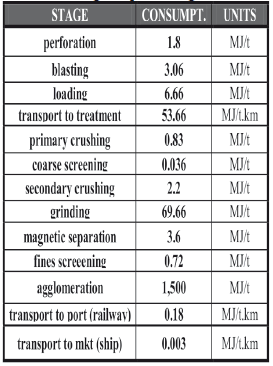
- CO2 emissions in mining and ore processing (units of kg CO2/t).
Energy consumption and CO2 emissions are closely related because the energy required by a particular process is directly related to CO2 emissions. Therefore, carbon dioxide emissions cannot be analysed as a single parameter in the index. CO2 emissions are dependent on the energy source used (coal, oil, natural gas, or renewable sources); therefore, the efficiency of energy consumption and the source cannot be defined using a single parameter. Similarly, an operation cannot be environmentally assessed using only energy consumption data. Depending on the energy source, the operation may emit so much CO2 into the atmosphere that it can be transformed from an energy-efficient exploitation to an environmentally deleterious process.
Table 2. CO2 emissions in ore mining and processing
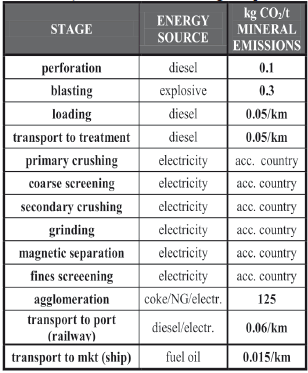
2.2 Influence of reducibility
The effects of selecting an appropriate iron ore are relevant when the ore is reduced in a blast furnace. Although hematite possesses a higher ratio of oxygen (O/Fe = 1.5) than does magnetite (O/Fe = 1.33), hematite is more easily reducible than magnetite because magnetite is crystalline (is less reactive and displays a lower ability to reduce than hematite).
Thus, the benefits achieved when pre-reducing iron ore must be introduced into the index. The use of pre-reduced ore as a raw material in a blast furnace effectively reduces energy consumption. This favourable effect was introduced into the energy impact index by applying the energy efficiency parameter mR. Although the efficiency of pre-reduced ore occurs downstream in the blast furnace, this efficiency is reflected in the EII calculation. The value calculated by the proposed tool is based on the processes and characteristics of the mineral ore (even the reducing conditions).
As an example, a quality lump ore only requires minor crushing and screening prior to transportation to the bulk carrier (DSO or direct shipping ore). The ore must comply with certain chemical (62 % Fe) and physical characteristics (including the size and ease of management of ore that is introduced into the blast furnace). Non-agglomerated ore represents 25 % of the iron used worldwide, and iron pellets represent another 25 % (1/3 of directly reduced iron). Sinter covers the remaining 50 % [4].
Due to the use of pre-reduced ore in the blast furnace, the rate of reducing agents in the blast furnace decreases, which saves energy. Whether significant energy savings can be achieved when the entire hot metal process is considered, including pre-reduced ore production processes, must be determined [6].
Natural lump ore has a lower degree of reduction than do iron pellets. Some authors suggest that this effect may be due to the greater porosity of the pellets [5].
The degree of reduction has been studied in detail. Specifically, the time required to secure a 90 % degree of reduction at a temperature of 880 ºC is approximately 120 minutes, whereas the time to secure a 60 % degree of reduction at the same temperature is 20 minutes. The productivity rate at a 60 % degree of reduction is approximately six times greater than that of a 90 % degree of reduction [6].
As a result, the unit energy consumption of the blast furnace decreases by 0.97 GJ/t pig iron or approximately 6 %. After taking into account the energy required to produce pre-reduced ore (0.94 GJ/t pig iron) and considering the reduction in energy required to transport the ore by sea to Japan (0.02 GJ/t pig iron), the decrease in energy consumption is 0.05 GJ/t pig iron or approximately 0.3 % [6].
Although is the aforementioned facts are widely accepted, the author concluded in another article that blast furnace processes are not negatively affected by the substitution of natural lump for iron pellets [7].
Therefore, when iron ore is pre-reduced, the reduction parameter (mR) should be used to decrease the energy consumption value of the EII. This reduction coefficient reaches a maximum value of 0.97.
Due to the fact that the real savings are produced upstream in the blast furnace (approximately 80 % of the total energy consumption), the introduction of this energy efficiency into early calculation stages can be considered to be a reward for saving energy when the furnace is fed with pre-reduced iron ore.
2.3 Influence of the chemical composition and mineral grade on later stages
According to the chemical composition and iron grade, mineral ore influences the energy requirements of blast furnaces used for the production of pig iron. The amount of slag is affected by the iron content (and gangue composition) and the amount of lime and limestone necessary to achieve adequate slag basicity.
The chemical composition and iron grade must be determined to modify the blast furnace energy demand (approximately 1-2 GJ/t) [4].
The energy needs of a blast furnace depend on the quality of the ore. As the metal content increases, the energy required for the production of iron decreases. A lower metal content results in more slag, as well as greater limestone additions and higher energy use. Variations in the chemical composition of ore can lead to 10-15 % differences in blast furnace energy use. The use of prepared burden (sinter and pellets) substantially reduces the coke ratio. Data for European blast furnaces suggest that the coke ratio increases from 330 to 410 kg/t as the prepared burden ratio decreases from 95 to 65 % (Lacroix, et al., 2001) [17]. However, the impact on the total blast furnace balance is less evident.
Chinese research indicates that if the iron content of the feedstock improves by 1 %, coke use decreases by 1.5-2 % (Yu, 2003; Wei 2006) [4].
2.4 Effect of the iron ore grade
Among industrial iron ores (magnetite, hematite, limonite and siderite), high-grade ores contain more than 55 % iron, while ores with iron contents below 25 % are considered economically non-exploitable (cut-off grade). The effects of the iron grade are more evident in the energy consumption of mining than the opportunities lost when a higher grade ore is not used (not to mention the improvement in product price and, approved break even iron grade, and the easier supplier differentiation).
When the iron grade is too low to transport the ore, the ore must be agglomerated which demands a considerable amount of energy (1,500 MJ/ton of ore during pelletisation [8]).
Because the energy demand depends on the iron grade, a magnetite with an iron content of 72 % can be compared to a hematite with an iron content of 62 %. For global processes involving iron ore, G1 hematite demands 9,978 MJ/ton of ore, while G2 magnetite requires 11.542 MJ/ton of ore [9]. The energy difference is equal to 10 %; therefore, the energy demands of the ores are similar.
The energy impact index considers the ore grade by applying a function that reflects the relationship between the iron percentage and CO2 emissions. The energy used to release low-grade iron ore is greater than the demands of a DSO. Nevertheless, at times, DSO does not have a high grade after mineral processing.
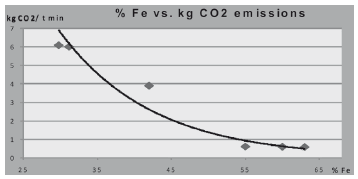
Figure 1. Iron ore grade and CO2 emissions
Therefore, an exponential function was adjusted to reflect the relationship between CO2 emissions and iron ore grade. This curve allows us to understand how energy consumption and emissions increase for lower iron ore grades (do not forget grinding limitations). When the grade is equal to 100 % iron, consumption decreases exponentially as the amount of CO2 decreases.
2.5 EII environmental impact weighting
Once energy consumption and CO2 emissions were considered for the EII, the environmental impact was assessed.
Different methodologies can be used to evaluate the environmental impact of a life-cycle (CML 2001, Cumulative Energy Demand, Ecological Footprint, Ecological Scarcity 1997, Eco-indicator 99, EPS 2000, Impact 2002+, IPCC 2001, BEES, etc.). Eco-indicator 99 [10] applies weighting factors to quantify the relevance of the impact of every product on the environment. These weights denote the views of society or a group of stakeholders, and are divided among basic questions such as human health, resources and ecosystem quality. The panel of experts was divided into three groups including individualists and egalitarians, which score ecosystem quality and human health as 80 % and resources as 20 %. Hierarchists score ecosystem quality and human health as 70 %, while resources are scored as 30 %.
The Environmental Impact Assessment of National Institute of Standards and Technology (NIST) [11] analyses six life-cycle assessment impact categories, including global warming (CO2, CH4 and NOX), acid rain, eutrophication, natural resource depletion, waste, indoor air quality and water intake, habitat alteration, smog, ozone depletion, ecological toxicity and human health. This score, along with economical considerations, is used to obtain a global impact score.
Following NIST guidelines, after the characteristics of iron mining were introduced, environmental impact was related to energy consumption (with fossil fuels as the main source) and CO2 emissions (which are derived from the energy demand and, include global warming hazards). Iron ore depletion is not considered a relevant impact, despite the growth in mineral consumption. [12]
BEES (Building for Environmental and Economic Sustainability, an environmental software created by NIST) was selected from different environmental impact assessments to develop the EII. Environmental impact categories can be classified according to their weights: 5 % impact for smog, ozone depletion and acid rain, 10 % impact for eutrophication, water intake, habitat alteration and ecological toxicity, and 30 % for global warming. After global warming, the most relevant contributor is fossil fuel depletion, which has a 10 % impact (followed by air contamination) [11].
NIST suggests that the most relevant contributors are global warming (30 %) and fossil fuel depletion (10 %). Considering only these impacts, new percentages were proposed for the EII. The percentages supported by hierarchists (human health = 70 % and resources = 30 %) were sufficient to infer the new weights. As a result, the impact of CO2 emissions was (global warming) equal to 70 %, while the impact of fossil fuel depletion was set to 30 %.
Table 3. Energy consumption and CO2 emissions weights

The proposed distribution originates from human concerns on global warming, which led to a higher weight for CO2 emissions than energy consumption (industrial emissions accounted for 14 % of human production, not considering a change in land use, agriculture and waste [13]. Of that proportion, 4 % was attributed to mining [4]. Moreover, from the global mining share, 2 % was derived from iron ore extraction [14]; however, with energy consumption, the biggest problem could be the depletion and substitution of fossil fuels).
Energy resource substitution (due to oil depletion) leads to the adoption of different sources with various green house gas emissions, depending on the source of energy (percentage of different electric power generation technologies) from every country. For instance, in countries with large hydraulic resources, the omission of oil would improve the environment, because a non-contaminating source would replace oil emissions; however, in countries (e.g., China) with a high percentage of coal power plants, oil replacement would not be positive from an environmental point of view.
Table 4. Consumption of iron-producing countries (Energy Information Administration)
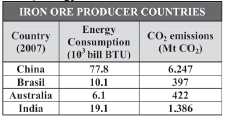
CO2 emissions are dependent on the carbon content. For instance, when 1 TJ of oil is consumed, 73 tons of CO2 are emitted into the atmosphere. In contrast, 56 tons of CO2 and 94 tons of CO2 are released due to the combustion of natural gas and coal, respectively [15].
Eco-Indicator 99 refers to impact percentages, obtained in Europe [10]. Compared to developing countries, fossil fuel depletion will not cause the same amount of harm in Europe, where this possibility was considered several years ago, and an efficient electricity transport and distribution system is operated.
2.6 Variations in the EII according to the type of iron ore
In some low grade iron ores, intensive grinding and separation (as well as sintering or pelletising) must be performed to release the mineral. Grinding consumes a significant amount of energy, and this issue is clearly exposed in the EII index. Energy consumption issues due to grinding are a common problem for magnetite and taconite.
2.7 Effects of gangue on performance (energy consumption)
The effects of gangue are exemplified by the fact that hematite and goethite are the most appropriate iron ores, while caolinite, gibbsite and quartz are considered gangue. For hematite, the releasing percentage is 87 %, with 53 microns, and the iron grade is 57.8 %-64.5 %. The Fe concentrate of hematite, reaches 66 %, and a performance of 62 %-86 % can be obtained; however, BHQ minerals (banded hematite quartzite), contain 66 % Fe with a flotation column, with 44.7 % performed [16, 17].
2.8 Influence of iron deposit selection
Iron deposit selection is relevant because it is the origin of the mineral, which affects its behaviour in subsequent transformation stages.
For instance, at Mesabi Range, the mineral grains are several microns in diameter; thus, intensive grinding must be conducted to release iron.
Alternatively, at Labrador Trough, the mineral was crystallised by metamorphism, leading to coarse grain iron ores with low energy demand.
Iron ores may also be related to carbonate rocks, which have high-grade iron hydroxides that are easy to mine, due to meteorisation and supergenic enrichment (which allows open pit mining without blasting).
Moreover, in taconite deposits (iron in layers with quartz, chert, or carbonate), erosion removes silicon, producing softer ores with 60 % iron, instead of 25 % iron, which is the initial iron content of taconites. [16, 17]
2.9 Influence of mineral use and ore processing.
Pelletising and sintering consume significant amounts of energy and emit large volumes of CO2, due to transport and blast furnace feed requirements (not to mention the ultimate purpose, which is to obtain fines for the production of steel).
Depending on the end-use of the iron ore(pig iron, sponge iron, commodities such as cement, etc.), different mineral properties are required.
Table 5. Iron ore sizes (CVRD 1985, QUARESMA 1987)
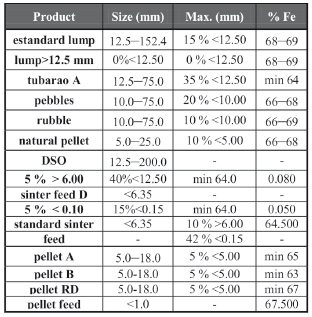
Iron ore is subjected to several processing stages to increase the iron content and reduce the amount of mineral impurities, depending on its end use. Ore processing is affected by the type of deposit and profit requirements. High-grade ores are treated to obtain a homogenous product, remove fines and reduce impurities. However, lower grade ores require mineral beneficiation to obtain a concentrate ore that can compete with high grade ores in international markets.
3. ENERGY IMPACT INDEX CONCRETION (EII)
Therefore, the EII index unifies energy consumption and CO2 emissions in all of the different processes. The index also considers the aforementioned parameters:
EII= f (CE, ECO2)
where EII is the energy impact index, CE is the energy consumption (MJ) and ECO2 is the amount of CO2 emissions (kg CO2).
Therefore, energy consumption depends on:
CE = f (D, M, Y, d, RM/E, TE, TD, W, L)
D: mineral hardness and grinding ability.
M: type of mineral (quality and size).
Y: type of deposit, structure and distribution.
d: distance from ore processing to the end customer (energy consumption and CO2 emissions are different when the ore is transported from Sweden to Rotterdam or Brazil to Asiatic blast furnaces).
RM/E: mineral/waste rate.
TE: type of exploitation, including standard open pit mining with significant amounts of earth movement, or selective underground mining.
TD: available technology (equipment and performance).
W: amount of ground clearing to reach the mineral ore (volume of soil removed for blasting or ripping out).
LFe: iron ore grade.
µR: energy efficiency parameter due to reducibility conditions.
CO2 emissions can be represented by the following function:
ECO2 = f (CE, F)
CE: energy consumption (MJ)
F: energy source (natural gas, oil, coal or renewable source)
4. EII IMPLEMENTATION IN REAL IRON MINING PROJECTS
The main features of iron deposits are shown in Table 6. The characteristics of iron were selected according to its location, particular infrastructure, type of mineral and related properties.
Table 6. Summary of features of selected iron deposits
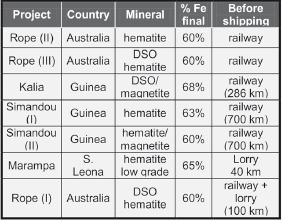
Table 7. Sustainability classification according to EII values
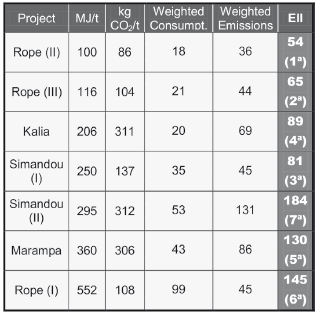
Once the deposits were defined, energy consumption and CO2 emissions were calculated for each stage, according to Tables 1 and 2. Afterwards, the calculated values were adjusted in accordance with the iron content (Table 6). Next, the weights were applied (Table 3). The energy impact index was obtained, and mineral deposits were ordered according to their EII to obtain a sustainability classification table (Table 7).
A comprehensive study was undertaken (Table 7) to determine the importance of distance. For instance, two deposits were located near Asiatic steel producers, and a railway was used for transportation. The other relevant effect was the use of hematite, a high quality mineral. According to the classification, a DSO was obtained in the first project.
The last project in the sustainability table was penalised due to the high weighting of CO2 emissions.
5. CONCLUSIONS
Therefore, energy consumption, CO2 emissions and processes that transform ore into blast furnace feedstock are the main characteristics affecting the sustainability of iron ore and mineral deposit mining.
The aforementioned information was properly weighted, and an iron deposit evaluation that can be used to develop a sustainability classification was obtained by introducing other EII-related parameters (please note that the EII results are relative values with regard to other mines and global circumstances).
Thus, energy consumption and CO2 emissions are merged into the new index, which assesses the energy required to perform essential processes according to the type of exploitation, technology applied, type of deposit, mineral/waste ratio, iron grade and other mineral features. The optimisation of the aforementioned parameters will lead to higher energy efficiencies (fossil fuel depletion is taken into account). CO2 emissions reflect the energy consumption and main energy sources used during mining (both of which are included in the energy impact index), which are the most significant issues, due to their impact on the environment. Other parameters that assess mineral and process characteristics are included in the index to an equal extent.
REFERENCES
[1] Crowson, P., Mineral Resources: The infinitely finite, The International Council on Metals and the Environment, Otawa, 1993. [ Links ]
[2] Espi, J.A., The scarcity-abundance relationship of mineral resources introducing some sustaintable aspects, Dyna, 77, pp. 21-29, 2010. [ Links ]
[3] Cawood, F., Kangwa, S., Mining, Minerals and Economic Development and Transition to Sustainable Development in Southern Africa [PhD Thesis]. University of the Witwatersrand, 2001. [ Links ]
[4] IEA, Tracking Industrial Energy Eficiency and CO2 Emissions. Paris, Organization for Economic Co-operation and Development, 2007. [ Links ]
[5] NATIONAL INSTITUTE OF TECHNOLOGY, Study on reduction kinetics of iron ore pellets by noncoking coal. Rourkela, 2009. [ Links ]
[6] Kunimoto, K., Fujiwara, Y., et al., Blast Furnace Ironmaking Process Using Pre-reduced Iron Ore, Nippon Steel Technical report, 94, 2006. [ Links ]
[7] Wu, S., Han Y., et al., Increasing Lump Ores Proportion in Blast Furnace Based on the High-temperature Interactivity of Iron Bearing Materials, ISIJ International, Vol. 50, (5), pp. 686-694, 2010. [ Links ]
[8] EUROPEAN COMISSION, Integrated Pollution Prevention and Control (IPPC). Best Available Techniques Reference Document on the Production of Iron and Steel. Bruxelles, 2001. [ Links ]
[9] De La Torre, L., El protagonismo de la energía en la clasificación ambiental de los proyectos de minerales de hierro. Memorias XV Congreso Geológico, Diagnóstico y Monitoreo Ambiental: Pasivos y Activos, Perú, 2010. [ Links ]
[10] PRé Consultants, The Eco Indicator 99. A damage oriented method for Life Cycle Impact Assessment. Netherlands, Ministerie van Volkshuijuesting, 2001. [ Links ]
[11] Lippiatt, B., Bees Online: Life cycle Analysis for Building Products, National Institute of Standards and Technology, U.S. Department of Commerce, 2010. [ Links ]
[12] Tilton, J. E., On borrowed time? Assesing the thread of mineral depletion, Resources for the future, Washington, 2002. [ Links ]
[13] Stern, N., Stern Review on the Economics of Climate Change, U.K. Treasury, Cambridge Univ. Press, 2006. [ Links ]
[14] Martens, P., Rattmann, L., Mining and Society: No Mining, No Future. XVII International Mining Congress and Exhibition of Turkey, 2001. [ Links ]
[15] BP, Statistical Review World Energy, 2010. Available: http://www.bp.com. [ Links ]
[16] Vázquez Guzmán, F., Geología Económica de los Recursos Minerales, Fundación Gómez Pardo, ETSIM, Madrid, 1996. [ Links ]
[17] Kesler, E., Mineral Resources, Economics and the Environment, Macmillan College Publishing Company, Inc., 1994. [ Links ]














